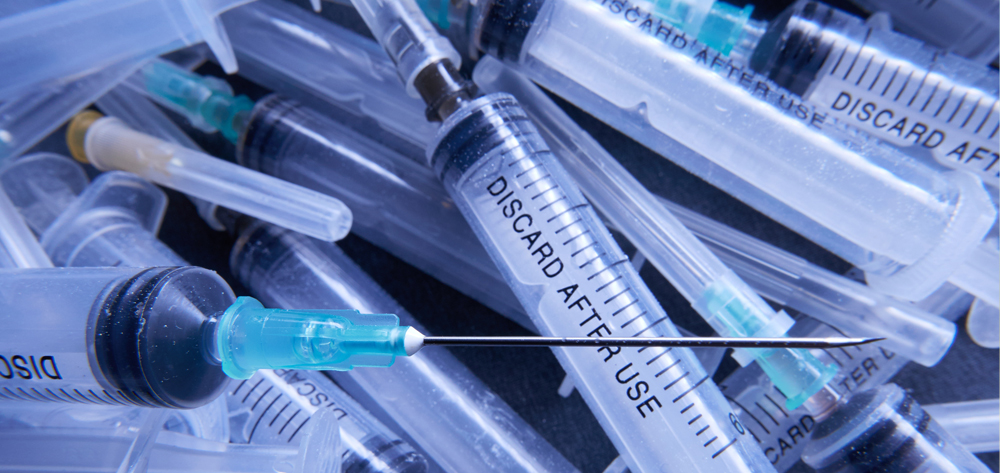Pharmaceutical waste from hospitals and homes is ending up in surface, ground, and drinking water. When it accumulates in the water supply from human excretion and improper disposal, it becomes an environmental contaminate (EC). This type of EC also pollutes surface water when the waste ends up in landfills, where it leaches out into the water table, or flushed down the toilet or sink to end up as sewage.
Unfortunately, modern sewage treatment facilities are not designed to filter out all pharmaceutical waste. A 2002 study by the U.S. Geological Survey found wastewater contaminants, such as drugs, hormones, steroids, and personal care product ingredients, in 80% of the 139 streams tested. Pharmaceutical ECs can act as endocrine disruptors. Environmental endocrine disruptors, including pharmaceutical waste, have been linked to abnormalities and impaired reproductive performance in some aquatic species and may affect humans.
There are few convenient and safe ways to dispose of unwanted pharmaceuticals. Flushing them down the toilet or sink is a typical, though environmentally unsustainable, practice in many healthcare facilities. Disposal of pharmaceutical waste is a growing challenge that federal and state regulators, the healthcare industry and other professions must work together to solve. Many factors complicate the issue. For example, various regulatory agencies control different aspects of the pharmaceutical waste stream, and individual state laws differ. Other sources of pharmaceuticals include pharmaceutical manufacturers and agriculture. Equipment contaminated with or used to administer drugs also may need to be disposed of in specific ways.
Typically, 2,000 to 4,000 different pharmaceuticals exist in a hospital pharmacy. The category the waste pharmaceutical falls in determines how to dispose of it. Careful segregation of pharmaceutical waste by well-trained employees is important. Hospital administration, nursing staff, pharmacy staff, environmental services, and the facility safety manager all need to acknowledge the importance of proper pharmaceutical waste disposal to protect the environment, cut costs, and avoid fines.
Hazardous pharmaceutical waste is a special category with specific laws governing its disposal. These pharmaceuticals appear on the Code of Federal Regulations lists of hazardous waste or have the characteristics of toxicity, corrosivity, reactivity, or ignitability. They must be disposed of by a hazardous waste broker under federal Resource Conservation and Recovery Act (RCRA) regulations. These regulations are complex and are described in more detail in the resources listed below. If discarded, about 5% of hospital pharmaceuticals are classified as hazardous waste. Another 10%, including many chemotherapy agents, should be managed as hazardous waste as a best management practice. Some hospitals are developing systems to inform nurses whether a drug is a hazardous waste and where to dispose of it.
Outdated drugs in their original packages may be eligible for reverse distribution, and the hospital may receive manufacturers’ credit for them. Nonhazardous medication waste may be disposed of through incineration by a hospital’s medical waste disposal company. Containers for both hazardous and nonhazardous pharmaceutical waste should be available.
Complicating the issue is the fact that controlled substances are regulated by the Drug Enforcement Administration (DEA) and must be destroyed by two nurses. Three controlled substances (chloral hydrate, paraldehyde, and phentermine) also fall under RCRA’s umbrella. Waste vendors registered with the DEA can handle this waste or it may be “sewered,” with written permission from the wastewater treatment plant and agreement with state and local regulations. Check with your nursing or pharmacy director about approved pharmaceutical disposal methods to ensure all local, state, and federal regulations are being followed.
Except with permission as detailed above, do not flush medications down the toilet or sink or throw them in the trash or in sharps containers. These actions may violate federal, state, and local laws. Collaborate with your pharmacy department to design a drug recycling or “take-back” program.
For more information, visit these websites:
- Hospitals for a Healthy Environment (H2E): www.h2e-online.org
- Minnesota Technical Assistance Program: http://mntap.umn.edu/health/94-PharmWaste.htm/li>
- PharmEcology Associates: www.pharmecology.com/li>
Holly Carpenter, BSN, RN, is the Maryland H2E nursing coordinator for the Maryland Nurses Association. Marian Condon, MS, RN, was senior staff specialist for ANA at the time of this writing and now is a consultant for Health Care Without Harm, Luminary Project in Arlington, Va.



















1 Comment.
Thanks for pointing out that it is not just important to know these things, but it is also stated in the law. With that in mind, I will suggest that my sister undergoes a training program regarding this since she is working in a hospital. She spread awareness or even invite her colleagues to learn how to handle waste properly.